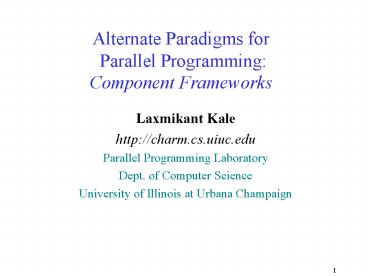Alternate Paradigms for Parallel Programming: Component Frameworks - PowerPoint PPT Presentation
Title:
Alternate Paradigms for Parallel Programming: Component Frameworks
Description:
Try to provide (approximatins of) shared memory paradigm, But ... AMRITA. Particles. 8. FEM Experience. Previous: 3-D volumetric/cohesive crack propagation code ... – PowerPoint PPT presentation
Number of Views:33
Avg rating:3.0/5.0
Title: Alternate Paradigms for Parallel Programming: Component Frameworks
1
Alternate Paradigms for Parallel
ProgrammingComponent Frameworks
- Laxmikant Kale
- http//charm.cs.uiuc.edu
- Parallel Programming Laboratory
- Dept. of Computer Science
- University of Illinois at Urbana Champaign
2
Distributed Shared Memory Approaches
- Try to provide (approximatins of) shared memory
paradigm, - But Run on distributed memory machines
- underneath,h you may have a cluster
- Treadmarks
- Uses (paged) virtual memory hardware
- AI not here causes OS interrupt
- Leads to message passing to get the page here
3
DSM Libraries
- CRL
- Simplified access model
- Shmem
- GA
4
DSM with compiler support
- UPC
- Co-array Fortran
5
Component Frameworks
- Motivation
- Reduce tedium of parallel programming for
commonly used paradigms - Encapsulate required parallel data structures and
algorithms - Provide easy to use interface,
- Sequential programming style preserved
- No alienating invasive constructs
- Use adaptive load balancing framework
- Component frameworks
- FEM
- Multiblock
- AMR
6
FEM framework
- Present clean, almost serial interface
- Hide parallel implementation in the runtime
system - Leave physics and time integration to user
- Users write code similar to sequential code
- Or, easily modify sequential code
- Input
- connectivity file (mesh), boundary data and
initial data - Framework
- Partitions data, and
- Starts driver for each chunk in a separate thread
- Automates communication, once user registers
fields to be communicated - Automatic dynamic load balancing
7
Common Framework Domains
- Structured Grids
- KelP
- MBlock
- Unstructured Grids
- Sierra
- Charm FEM framework
- AMR for each
- SAMRAI
- AMRITA
- Particles
8
FEM Experience
- Previous
- 3-D volumetric/cohesive crack propagation code
- (P. Geubelle, S. Breitenfeld, et. al)
- 3-D dendritic growth fluid solidification code
- (J. Dantzig, J. Jeong)
- Recent
- Adaptive insertion of cohesive elements
- Mario Zaczek, Philippe Geubelle
- Performance data
- Multi-Grain contact (in progress)
- Spandan Maiti, S. Breitenfield, O. Lawlor, P.
Guebelle - Using FEM framework and collision detection
- NSF funded project
- Did initial parallelization in 4 days
9
Performance data ASCI Red
Mesh with 3.1 million elements
Speedup of 1155 on 1024 processors.
10
Dendritic Growth
- Studies evolution of solidification
microstructures using a phase-field model
computed on an adaptive finite element grid - Adaptive refinement and coarsening of grid
involves re-partitioning
Jon Dantzig et al with O. Lawlor and Others from
PPL
11
Overhead of Multipartitioning
Conclusion Overhead of virtualization is small,
and in fact it benefits by creating automatic
12
Parallel Collision Detection
- Detect collisions (intersections) between objects
scattered across processors
- Approach, based on Charm Arrays
- Overlay regular, sparse 3D grid of voxels (boxes)
- Send objects to all voxels they touch
- Collide objects within each voxel independently
and collect results - Leave collision response to user code
13
Parallel Collision Detection
- Results 2?s per polygon
- Good speedups to 1000s of processors
ASCI Red, 65,000 polygons per processor. (scaled
problem) Up to 100 million polygons
- This was a significant improvement over the
state-of-art. - Made possible by virtualization, and
- Asynchronous, as needed, creation of voxels
- Localization of communication voxel often on the
same processor as the contributing polygon
14
Application
Orchestration Support
Data transfer
Application Components
D
C
A
B
Framework Components
Unmesh
MBlock
Particles
AMR support
Solvers
Parallel Standard Libraries

